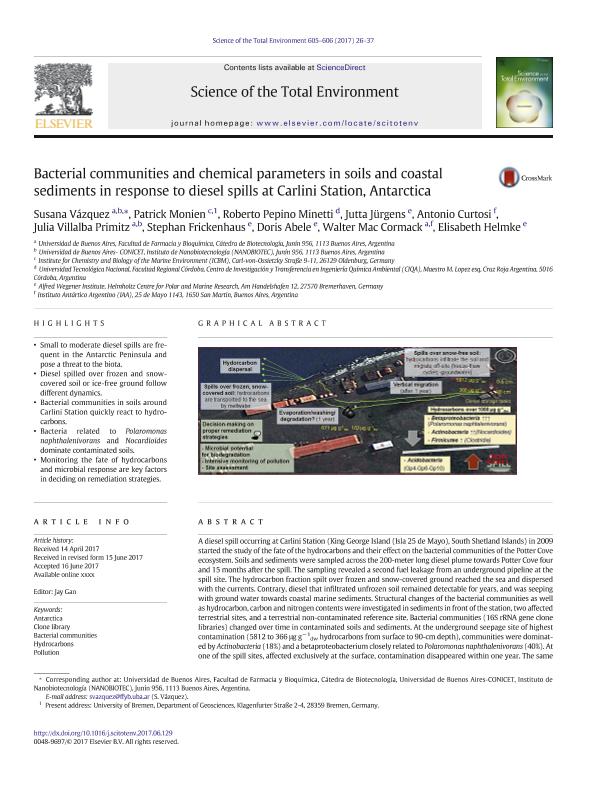Mostrar el registro sencillo del ítem
dc.contributor.author
Vázquez, Susana Claudia

dc.contributor.author
Monien, Patrick
dc.contributor.author
Pepino Minetti, Roberto
dc.contributor.author
Jürgens, Jutta
dc.contributor.author
Curtosi, Antonio

dc.contributor.author
Villalba Primitz, Julia Elena Rosina

dc.contributor.author
Frickenhaus, Stephan

dc.contributor.author
Abele, Doris
dc.contributor.author
Mac Cormack, Walter Patricio

dc.contributor.author
Helmke, Elisabeth
dc.date.available
2018-06-06T19:25:23Z
dc.date.issued
2017-12
dc.identifier.citation
Vázquez, Susana Claudia; Monien, Patrick; Pepino Minetti, Roberto; Jürgens, Jutta; Curtosi, Antonio; et al.; Bacterial communities and chemical parameters in soils and coastal sediments in response to diesel spills at Carlini Station, Antarctica; Elsevier; Science of the Total Environment; 605-606; 12-2017; 26-37
dc.identifier.issn
0048-9697
dc.identifier.uri
http://hdl.handle.net/11336/47561
dc.description.abstract
A diesel spill occurring at Carlini Station (King George Island (Isla 25 de Mayo), South Shetland Islands) in 2009 started the study of the fate of the hydrocarbons and their effect on the bacterial communities of the Potter Cove ecosystem. Soils and sediments were sampled across the 200-meter long diesel plume towards Potter Cove four and 15 months after the spill. The sampling revealed a second fuel leakage from an underground pipeline at the spill site. The hydrocarbon fraction spilt over frozen and snow-covered ground reached the sea and dispersed with the currents. Contrary, diesel that infiltrated unfrozen soil emained detectable for years, and was seeping with ground water towards coastal marine sediments. Structural changes of the bacterial communities as well as hydrocarbon, carbon and nitrogen contents were investigated in sediments in front of the station, two affected terrestrial sites, and a terrestrial non-contaminated reference site. Bacterial communities (16S rRNA gene clone libraries) changed over time in contaminated soils and sediments. At the underground seepage site of highest contamination (5812 to 366 μgg−1dw hydrocarbons fromsurface to 90-cm depth), communities were dominated by Actinobacteria (18%) and a betaproteobacteriumclosely related to Polaromonas naphthalenivorans (40%). At one of the spill sites, affected exclusively at the surface, contamination disappeared within one year. The same bacterial groups were enriched at both contaminated sites. This response at community level suggests that the cold-adapted indigenous microbiota in soils of the West Antarctic Peninsula have a high potential for bioremediation and can support soil cleaning actions in the ecosystem. Intensive monitoring of pollution and site assessment after episodic fuel spills is required for decision-making towards remediation strategies.
dc.format
application/pdf
dc.language.iso
eng
dc.publisher
Elsevier

dc.rights
info:eu-repo/semantics/openAccess
dc.rights.uri
https://creativecommons.org/licenses/by-nc-sa/2.5/ar/
dc.subject
Antarctica
dc.subject
Clones Library
dc.subject
Bacterial Communities
dc.subject
Hydrocarbons
dc.subject
Pollution
dc.subject.classification
Otras Ciencias Biológicas

dc.subject.classification
Ciencias Biológicas

dc.subject.classification
CIENCIAS NATURALES Y EXACTAS

dc.title
Bacterial communities and chemical parameters in soils and coastal sediments in response to diesel spills at Carlini Station, Antarctica
dc.type
info:eu-repo/semantics/article
dc.type
info:ar-repo/semantics/artículo
dc.type
info:eu-repo/semantics/publishedVersion
dc.date.updated
2018-06-06T13:46:10Z
dc.journal.volume
605-606
dc.journal.pagination
26-37
dc.journal.pais
Países Bajos

dc.journal.ciudad
Amsterdam
dc.description.fil
Fil: Vázquez, Susana Claudia. Consejo Nacional de Investigaciones Científicas y Técnicas. Oficina de Coordinación Administrativa Houssay. Instituto de Nanobiotecnología. Universidad de Buenos Aires. Facultad de Farmacia y Bioquímica. Instituto de Nanobiotecnología; Argentina
dc.description.fil
Fil: Monien, Patrick. Institute for Chemistry and Biology of the Marine Environment; Alemania. Universitat Bremen; Alemania
dc.description.fil
Fil: Pepino Minetti, Roberto. Universidad Tecnológica Nacional. Facultad Regional Córdoba; Argentina
dc.description.fil
Fil: Jürgens, Jutta. Alfred-Wegener-Institut Helmholtzzentrum für Polar und Meeresforschung; Alemania
dc.description.fil
Fil: Curtosi, Antonio. Ministerio de Relaciones Exteriores, Comercio Interno y Culto. Dirección Nacional del Antártico. Instituto Antártico Argentino; Argentina
dc.description.fil
Fil: Villalba Primitz, Julia Elena Rosina. Consejo Nacional de Investigaciones Científicas y Técnicas. Oficina de Coordinación Administrativa Houssay. Instituto de Nanobiotecnología. Universidad de Buenos Aires. Facultad de Farmacia y Bioquímica. Instituto de Nanobiotecnología; Argentina
dc.description.fil
Fil: Frickenhaus, Stephan. Alfred-Wegener-Institut Helmholtzzentrum für Polar und Meeresforschung; Alemania
dc.description.fil
Fil: Abele, Doris. Alfred-Wegener-Institut Helmholtzzentrum für Polar und Meeresforschung; Alemania
dc.description.fil
Fil: Mac Cormack, Walter Patricio. Ministerio de Relaciones Exteriores, Comercio Interno y Culto. Dirección Nacional del Antártico. Instituto Antártico Argentino; Argentina. Universidad de Buenos Aires. Facultad de Farmacia y Bioquímica; Argentina
dc.description.fil
Fil: Helmke, Elisabeth. Alfred-Wegener-Institut Helmholtzzentrum für Polar und Meeresforschung; Alemania
dc.journal.title
Science of the Total Environment

dc.relation.alternativeid
info:eu-repo/semantics/altIdentifier/url/http://www.sciencedirect.com/science/article/pii/S0048969717315334
dc.relation.alternativeid
info:eu-repo/semantics/altIdentifier/doi/http://dx.doi.org/10.1016/j.scitotenv.2017.06.129
Archivos asociados
